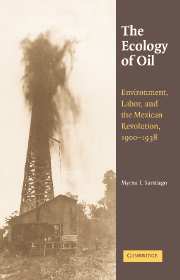Book contents
- Frontmatter
- Dedication
- Contents
- List of Maps, Figures, Tables, and Appendices
- Acknowledgments
- Introduction
- PART ONE THE HUASTECA BEFORE OIL
- PART TWO THE ECOLOGY OF OIL
- PART THREE CHALLENGING THE ECOLOGY OF OIL
- Conclusion
- Epilogue
- Appendices
- A Note on the Sources
- Archives Consulted
- Selected Bibliography
- Index
Introduction
Published online by Cambridge University Press: 05 March 2015
- Frontmatter
- Dedication
- Contents
- List of Maps, Figures, Tables, and Appendices
- Acknowledgments
- Introduction
- PART ONE THE HUASTECA BEFORE OIL
- PART TWO THE ECOLOGY OF OIL
- PART THREE CHALLENGING THE ECOLOGY OF OIL
- Conclusion
- Epilogue
- Appendices
- A Note on the Sources
- Archives Consulted
- Selected Bibliography
- Index
Summary
The casual traveler on tour through northern Veracruz today might never guess that in 1921 oil spurted from the area in such prodigious quantities that Mexico became the third largest petroleum producer in the world. The main economic activities along the 120 miles from Tuxpan to Tampico, part of the territory known as the Huasteca, are cattle ranching and citrus production. With the exception of the town of Cerro Azul, which welcomes visitors with a gigantic commemorative oil derrick, the fields that produced millions of barrels of crude in the first three decades of the twentieth century are nowhere in evidence. Potrero del Llano, a legendary and once immensely rich oil field, has a main street that is one block long and unpaved. Slow-moving cows ruminate in the grasslands, seeking relief from the heat and the humidity underneath scattered palms or short trees. Zacamixtle, Juan Felipe, and others are likewise small cattle ranching communities where oil ghosts roam undetected.
The observant tourist, nonetheless, can find the imprint of the oil industry in the landscape. The most obvious signs are the bright mustard-yellow Petróleos Mexicanos (PEMEX) posts painted with black skull-and-crossbones alerting passersby to the presence of underground pipelines. The signs admonish PELIGROand prohibit “banging” and “excavating.” When they are at water's edge, the signs also ban “anchoring.” In former refinery towns, such as El Ebano and Mata Redonda, the oil relics are the wooden bungalows the companies built to house Mexican workers. Scattered among new concrete homes, some bungalows are crumbling. Their wooden doors are falling off the hinges and the stilts to prevent flooding are eroded and gnawed. But many more are painted in brilliant pinks, greens, yellows, and blues, surrounded by potted plants and trees recently planted, still inhabited nearly ninety years after they were built. More difficult to find is San Diego de la Mar, the location of the most notorious oil well explosion in the history of the industry, “Dos Bocas.”
- Type
- Chapter
- Information
- The Ecology of OilEnvironment, Labor, and the Mexican Revolution, 1900–1938, pp. 1 - 12Publisher: Cambridge University PressPrint publication year: 2006

